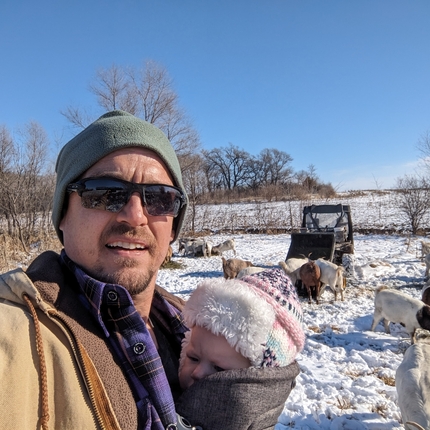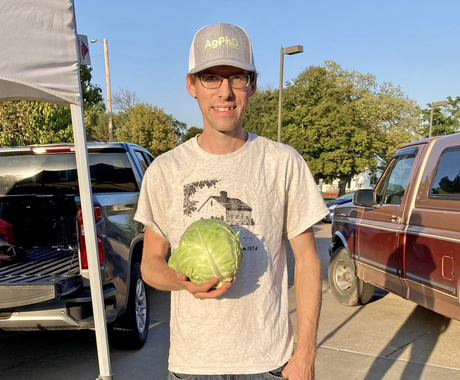Para la versión en español, oprima aquí.
Lucia Schulz contributed to this story.
John Wallace has always had a preference for small ruminants (sheep and goats). He was reared around agriculture, and, although he stepped away for a few years while he was in the military, farming has been his long-term plan.
In 2017, he started raising goats on his current operation, Olive Branch Goats, in Palmyra, Nebraska, because of lower predation risk and a slight preference over sheep. He hopes to eventually add sheep and cattle.
This year, he has been welcoming guests to his farm and offering his expertise to attendees of the Center for Rural Affairs workshop series “The Cycle of a Goat Dairy or Meat Operation,” designed for those interested in starting their own goat operations.
How it began and how it’s going
Coming from a multi-generational animal agricultural background and growing up on a sheep ranch, John got his first taste of caring for his own animals at 8, when he got a dairy goat as a 4-H project. Since then, his parents, who both have postgraduate degrees in animal agriculture-related fields and decades of experience in the area, have provided guidance.
Today, John owns 5 acres of land and wishes he had held out for a larger plot.
“At the time, I was excited to get out of the city and felt like 5 acres would be big enough for a while and we could try to find more nearby, but it didn’t work out that way,” John said.
Having limited space makes land use a priority, and he said he watches real estate listings for more land to buy.
“Every square foot used for driveway, hay storage, or a building is one less square foot of pasture,” John said. “I built efficient systems that do not waste potential grazing areas. We purchased an additional 60 acres in another county we will eventually move to. The cost of land in this area is prohibitive to expansion here.”
John has around 35 head of production does and is looking to scale that up to 50 head in the next two years. After moving to his other property, he hopes to expand to 100 or more head and add custom cattle.
Until then, he has worked out a deal with neighbors.
“I clear snow for my neighbors in the winter,” John said. “Inevitably, they asked me what they could do to pay me back, and I asked about grazing ground they aren’t using. In general, the agreement continues under these terms: I clear their snow in the winter and let them borrow my skid loader occasionally, and I get to graze their otherwise unused ground.”
Mastering the market and making sales
Most people who keep livestock in John’s area see the animals as pets or show stock, he said.
“Most households, in general, do not contain farmers; occupants live on acreages but do not participate in agriculture,” John said. “Most serious commercial farming around me is row-cropping. Generally speaking, they are friendly and helpful if I ask for it. Some serious farmers will dismiss anyone with goats as ‘just a hobby’ due to a lack of understanding of the modern market.”
John has put a lot of time and effort into finding the right buyers. He moves his products in several ways, including auctions and website sales.
“I usually sell at auctions, and I make some effort to get to know the movers and shakers, in particular order-buyers, as working with them directly can save commission and yardage charge from the sale barn,” he said. “For direct-to-consumer marketing, I have created a website and Google Maps listing, as well as dropped off business cards at ethnic food stores in Lincoln, Nebraska.”
John also sells to specific markets and has contracts with some bulk order buyers. He pays attention to overall trends, using U.S. Department of Agriculture market reports and evaluating price trends at different markets.
“For annual kid crops, usually the Clay Center Livestock Market wins out,” John said. “The increased transport costs are worthwhile due to the number of head being sold. For smaller groups of culls, the Palmyra Livestock Market usually wins due to mileage and time overhead being very low for a small number of head.”
John said he generally sells bottle kids privately and quickly because labor and milk replacer inputs are too high to justify artificial rearing when the young animals can fetch very healthy prices.
The goat market is highly seasonal, with a price peak in March and a low in September or October.
“I have access to relatively inexpensive feed in the fall and early winter in the form of row crop residue,” he said. “I now keep kid crops (that were weaned in early September) until the first of February to hit that early peak market.”
Advice and resources for aspiring farmers
To those considering trying to make a living in agriculture, John said, it’s a lifestyle that most folks who are successful are born into.
“If you don’t have a background in animal agriculture, it could be very tough,” he said. “I suggest working for someone else to get some experience before risking your own capital.”
John also feels that finding a mentor to work with is important; preferably someone who’s been in commercial agriculture for at least 10 years. He has been fortunate to be able to lean on his parents for support.
“They have given me advice many times,” he said. “I also follow several farms and ranches on social media, and make it a point to be active in organizations that serve as knowledge- and experience-sharing venues, such as the Nebraska Sheep and Goat Producers Association.”
John said he uses traditional risk mitigation and planning techniques.
“I have a personal doctrine of not making rigid plans, but instead ensuring options are available,” he said. “Those options become contingencies and allow us to be flexible to reality. For example, if we are experiencing a drought, I have the option of selling kids early, grazing our other property, irrigating select pastures, utilizing hay reserves, etc. Some of those options are also contingencies for other problems, such as an early or prolonged winter, a market collapse, or other unforeseen things.”
John said there are realistic, and at times, harsh expectations to consider. Still, it's the best job he’s ever had or could dream of having.
“Don’t buy them or breed them unless you are ready to watch them die,” John said. “If you’re not comfortable with that, this is not the line of work for you. Make sure you have a day job. Don’t let this be your only source of income, especially if you have a family to take care of. This life is challenging and rewarding, and it’s always been the one consistent thing I wanted to do. I was born into this.”
To learn more about what it takes to run a commercially run goat operation, view our case study here.





